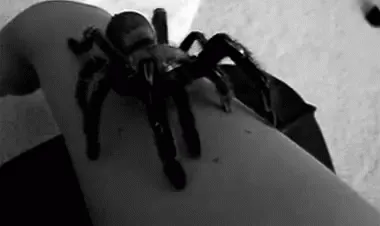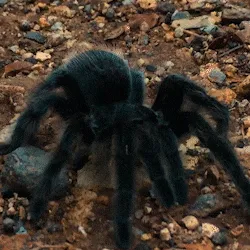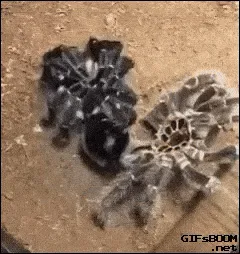Discovering a tarantula in or around your home can be a startling experience, especially if you’re a dog owner. These large, hairy spiders can be intimidating, and the potential for interaction with your furry friend raises concerns. This comprehensive guide provides essential information on identifying tarantulas, understanding their behavior, and implementing effective strategies to remove them from your property while ensuring the safety of your dog. Learn how to identify potential risks and find the right solutions.
Identifying Tarantulas Around Your Home
Before you can effectively address a tarantula problem, it’s crucial to identify the presence of these arachnids. Tarantulas are generally large spiders, often with hairy bodies and long legs. They vary in color, ranging from brown to black, and some species have vibrant markings. The size of the tarantula can be a significant factor in identification, with some reaching impressive lengths. Accurate identification will help you assess the potential risks and choose the most appropriate course of action for removal or prevention. Observing the tarantula’s appearance and size is an important step.
Signs of Tarantula Presence
Tarantulas, being nocturnal creatures, are not always easy to spot directly. Instead, look for signs that indicate their presence. These signs include shed exoskeletons, which tarantulas leave behind as they grow. You may also find silk webbing, though tarantulas don’t spin webs in the same way as other spiders; they might create silk retreats in burrows or under objects. Additionally, observe for the tarantula’s burrows, often found in the ground, under rocks, or near structures. Seeing these signs will help you confirm that you may have a tarantula problem and take appropriate steps.
Where Tarantulas Hide

Tarantulas are secretive creatures, preferring to hide in concealed locations. They often take shelter in burrows, which they may dig themselves or utilize existing holes in the ground. They may also be found under rocks, logs, or debris in your yard. Inside the house, tarantulas might hide in dark, undisturbed areas like basements, crawl spaces, or closets. Understanding where tarantulas prefer to hide is critical for inspection and removal. Regularly checking these areas can help you discover and address any tarantula infestations early, before they become a bigger problem for you and your dog.
Why Tarantulas Might Be in Your Home
Several factors can attract tarantulas to your property. They are often drawn by the availability of food sources, such as insects and other small invertebrates. Your yard’s insect population may provide a buffet, encouraging them to stay. The presence of suitable shelter, such as burrows or hiding places, also makes your home attractive. Temperature and humidity also play a role, with tarantulas preferring warmer and more humid environments. Furthermore, if you have a dog, the dog’s presence may inadvertently create a favorable environment. If your dog leaves food or water outside, it may also attract insects, which, in turn, can draw in tarantulas.
Effective Methods for Tarantula Removal
Once you’ve identified tarantulas on your property, the next step is removal. Several effective methods can help you eliminate these spiders and reduce the risk to your dog. Consider your comfort level and the environment to decide on the best approach. Always prioritize safety, and if you’re not comfortable handling tarantulas, consider seeking professional pest control services. Remember that the goal is to safely and humanely remove the tarantulas while protecting your dog.
Physical Removal Techniques

For a direct approach, you can physically remove tarantulas. If you encounter a tarantula, and you’re comfortable doing so, you can capture it using a container and a piece of cardboard. Carefully place the container over the tarantula and slide the cardboard underneath to trap it. Then, transport the spider far away from your home and release it in a safe area. Always wear gloves and eye protection to avoid any accidental bites or contact with urticating hairs (the hairs that tarantulas use for defense). Be cautious, as tarantulas can bite if they feel threatened.
Using Traps to Catch Tarantulas
Traps can be an effective method for catching tarantulas. Glue traps, commonly used for other pests, can also catch tarantulas. Place these traps in areas where you suspect tarantula activity, such as near burrows or along walls. Ensure the traps are out of reach of your dog to prevent accidental entanglement. Regularly check the traps and dispose of them when they are full or no longer effective. Although traps aren’t a long-term solution, they can help reduce the tarantula population and offer a way to capture individual spiders.
Natural Repellents to Deter Tarantulas
Using natural repellents can help keep tarantulas away. Certain essential oils, such as peppermint, tea tree, and citrus, are known to repel spiders. Mix a few drops of essential oil with water and spray it in areas where you suspect tarantula activity. You can also plant herbs like mint and lavender, which have natural repellent properties. Another option is to spread diatomaceous earth (DE), a natural powder made from fossilized algae, around potential entry points and hiding spots. DE is abrasive to insects but safe for pets and humans if used correctly. Be sure to reapply repellents regularly, especially after rain.
Preventing Tarantula Infestations

Prevention is critical to avoid tarantula problems. Implementing preventative measures can significantly reduce the likelihood of tarantulas entering your home and yard. This not only protects your dog but also gives you peace of mind. By addressing potential entry points, maintaining a clean yard, and controlling insect populations, you can create an environment less attractive to these spiders.
Sealing Entry Points
Inspect your home’s exterior for any cracks, gaps, or holes that tarantulas could use to enter. Seal these entry points with caulk, weather stripping, or other appropriate materials. Pay close attention to areas around windows, doors, pipes, and vents. Ensure that screens on windows and doors are intact and free of holes. By closing these entry points, you can significantly reduce the chances of tarantulas finding their way inside your home. Regularly check and maintain these seals to maintain effective protection.
Maintaining a Clean Yard
A clean yard is less attractive to tarantulas. Regularly remove any piles of debris, such as leaves, woodpiles, and overgrown vegetation, which provide shelter for spiders and insects. Keep your lawn mowed, and trim any bushes or shrubs that touch your home. Proper outdoor lighting can also deter tarantulas, as they are attracted to insects that gather near lights. Removing these potential hiding spots and food sources can make your yard less inviting to tarantulas, reducing the chance they will venture near your home and your dog.
Controlling Insect Populations

Tarantulas feed on insects, so controlling insect populations in your yard can help prevent tarantulas. Use insect control methods, such as insecticides or natural pest control solutions, to reduce the number of insects available as prey. Keep your yard free of standing water, which can attract mosquitoes and other insects. Consider using insect-repellent plants to deter insects and, consequently, tarantulas. By managing the food supply, you can limit the appeal of your yard to these spiders.
What to Do if Your Dog Encounters a Tarantula
Even with preventive measures, your dog might encounter a tarantula. Knowing how to react and what steps to take can help ensure your dog’s safety. It’s essential to be prepared and aware of the signs of a bite and the proper course of action. The following information will prepare you to handle the situation if your dog ever interacts with a tarantula.
Recognizing Tarantula Bite Symptoms in Dogs
If your dog is bitten by a tarantula, you may notice specific symptoms. These can include localized pain, swelling, and redness around the bite area. Your dog might excessively lick or scratch the affected area. Other signs include drooling, vomiting, or difficulty breathing. In severe cases, a dog could experience muscle spasms, tremors, or paralysis. Recognizing these symptoms early is essential for seeking timely veterinary care. If you suspect your dog has been bitten, observe them closely for any of these indicators.
First Aid for Tarantula Bites

If you suspect your dog has been bitten by a tarantula, provide immediate first aid. First, try to keep your dog calm to prevent the venom from spreading. Gently clean the bite area with mild soap and water. Apply a cold compress to reduce swelling and discomfort. Monitor your dog closely for any adverse reactions. If the symptoms worsen, or if you are unsure about the severity of the bite, seek immediate veterinary attention. Provide the vet with as much information as possible, including the type of spider (if known) and the time of the bite.
When to Seek Veterinary Care
It’s always best to err on the side of caution when it comes to tarantula bites. Seek immediate veterinary care if your dog exhibits severe symptoms like difficulty breathing, excessive drooling, or muscle tremors. Also, if you’re uncertain about the bite’s severity, consult a vet. The veterinarian can assess your dog’s condition, provide appropriate treatment, and administer any necessary medications. Your vet can also offer guidance on how to prevent future encounters. Early intervention can make a significant difference in your dog’s recovery, so don’t hesitate to seek professional help.
Dealing with tarantulas at home, especially with a dog, requires knowledge, vigilance, and proactive measures. By identifying tarantulas, removing them, and implementing preventative strategies, you can create a safer environment for your pet and your family. Remember to remain cautious, use safe practices, and seek professional help when necessary. By following these steps, you can effectively manage the tarantula population on your property and ensure the safety and well-being of your beloved canine companion.
